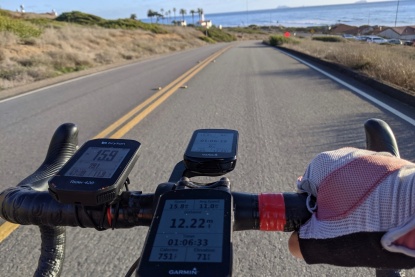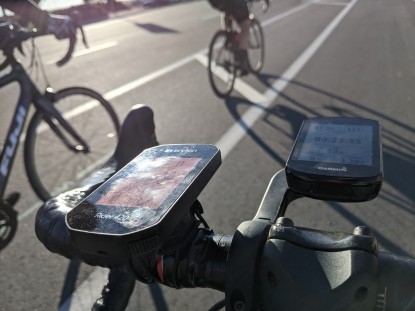The Sigma 1609 provides cadence and stopwatch functions that our Best Buy winner, the Cateye CC-RD300W Strada Wireless Bike Computer, does not, but is hindered by the lengthy set-up and wires necessary for the sensors. Even though the 1609 offers these extra perks, it scores below our Top Pick winner, the STRAVA app, and also well below the Editors' Choice Garmin Edge 810 in terms of features.
A good alternative would be the wireless version of this computer. The Sigma BC1609 Double Wireless Bicycle Speedometer is $94.99, and offers the same functionality without the wires.Sigma BC1609 Cadence Review
Our Verdict
Our Analysis and Test Results
Ease of Use
The Sigma 1609, much like its hair-to-the-wind wireless cousin, the Sigma BC 1009 STS Wireless, is a little more difficult to set up than some of the other computers we tested. The 1609 is hampered by wires, in addition to the four different unmarked buttons you must dig through the guide in order to learn what they do.
While riding, the Sigma 1609, like the 1009 is also very easy to read and scroll through modes. Speed is prominently displayed as the largest piece of info, and one other mode is shown one at a time.
Features
The Sigma 1609 bike computer tracks current speed, average speed, maximum speed, current cadence, average cadence, trip distance, and trip time. It also has an odometer for all-time mileage, a clock, temperature, and overall ride time for the computer. The 1609 includes a stopwatch and countdown function for intervals and more in depth training, two functions the 1009 does not include.
Just like with the 1009, the more useful information while riding — trip time, average speed, max speed, average cadence and trip distance, — are switched by hitting 'mode 2.' The clock, odometer, cadence, and total time are switched between by hitting 'mode 1.' This is a very nice feature, limiting how many metrics you must pass before finding the one you want. It keeps the less relevant data from distracting you while riding, but it's still accessible for breaks or after you finish.
The screen of the Sigma 1609 is the exact same as the Sigma 1009, and a little bigger than the Cateye Strada. However, the 1609 still only displays two modes at one time, just utilizing a larger display size.
The four buttons aren't terribly confusing, but are more complicated than the Cateye Strada's single click function. The introduction of cadence and the additional timer features adds a little more complication to finding what mode you want, but the benefits of these features outweigh the hassle. The computer mounts very securely.
Attachment Method
Wires. Everywhere. Sigma does provide industrial strength rubber bands for the 1609 mount and sensor as well, but the rubber bands don't take care of the wires you must feed all along your bike — that is what zip-ties are for.
The 1609 attaches to the mount on your handlebar, and then a wire must wrap around your brake cable and run down the left side of your front fork to a sensor that can be banded there. Another wire must run along your down-tube to the bottom bracket, where it can be secured. The sensor on the fork is for speed, and had to be secured quite high because the spoke magnet doesn't fit blade spokes very well. The sensor on the bottom bracket has to be aligned with the cadence pod zip-tied to the crank. The wires are extra long, so doubling them up and zip-tying them down is your only choice.
Best Application
The Sigma 1609 is a good choice for road cyclists. The large screen and square size are a good combination for visibility. The addition of cadence, stopwatch, and countdown make it a more serious training tool than the Sigma 1009 or Cateye Strada.
Value
The Sigma 1609 is at the lower price spectrum for non-GPS computers we tested at $44.99. If you value the training tools the 1609 has to offer and don't mind the set-up, it might be the most bang for your buck. a good option.




